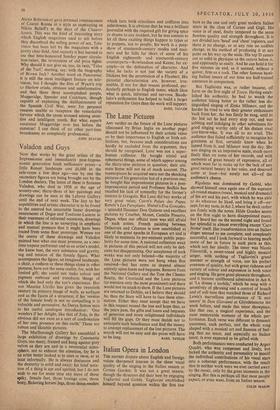Valadon and Guys
Now that works by the great artists of the Impressionist and immediately post-Impres- sionist generation fetch millionaire prices—a little Renoir landscape cost £6,000 in the sale-room a few days ago—one by one the secondary figtires arc being brought out by the London dealers. The latest of these is Suzanne Valadon, who died in 1938 at the age of seventy-one; thirty-three of her paintings and drawings can be seen at the Lefevre Gallery until the end of next week. The key to her capabilities and artistic character is to be found in the assured but unsuitable linear drawings reminiscent of Degas and Toulouse-Lautrec in their treatment of informal occasions, drawings in which the line is so unvarying in emphasis and manual pressure that it might have been traced from some finer prototype. Women are the centre of these drawings and Valadon painted best what one must presume, as a one- time trapeze performer and as an artist's model, she knew best, the very substance and gravity, sag and tension of the female figure. What accompanies the figure, an imagined landscape, a chair, a cushion or these things alone in other pictures, have not the same reality, for, with her limited gift, she could not make colour and pigment embrace and transform things of which she had only the eye's experience. Her son Maurice Utrillo has given the twentieth century its primary image of walls, as surfaces and as the facets of a structure; if her version of the female body is not so compelling it is valuable and persuasive. As Denys Sutton says in his useful catalogue introduction : 'One wonders if her delight, like that of Zola, in the obvious did not exist as a sort of confirmation of her own. presence on this earth.' These are robust and likeable pictures.
which turn both crinolines and coiffures into eiderdowns. It is obvious that he was a brilliant journalist with the required gift for giving spice or drama to any incident, but he was content to let all these exciting things happen to types or to puppets, not to people; his work is a peep- show of nineteenth-century modes and man- ners and he falls far short of some of his English eighteenth- and nineteenth-century counterparts—Rowlandson and Keene. for ex- ample—in the delineation of character. • And what he lacks is not just the variety of a Dickens but the penetration of a Flaubert. His pictorial characteristics are, however, irre- sistible, if not for that reason profound, par- ticularly perhaps to English tastes, which likes what is quick, informal and nervous. Baude- laire's enthusiasm has helped to build a larger reputation for Guys than the work will support.
BASIL TAYLOR


















































 Previous page
Previous page